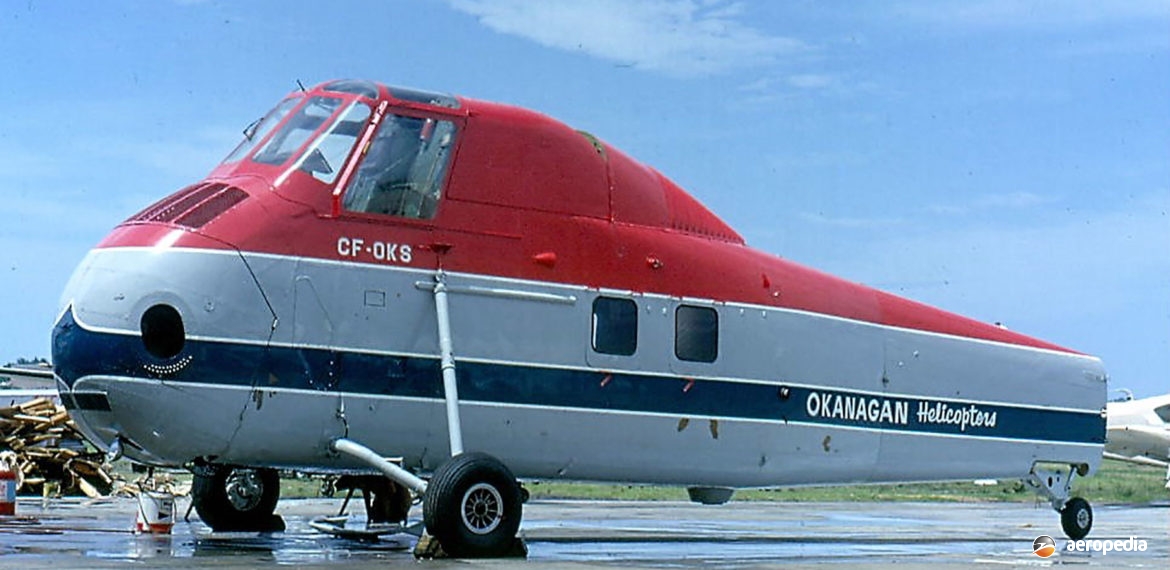Photograph:
Sikorsky S-58 CF-OKS (c/n 58-414) at Mascot, NSW in January 1967 (David C Eyre)
Country of origin:
United States of America
Description:
General purpose utility helicopter
Power Plant:
(S-58)
One 1,138 kw (1,525 hp) Wright R-1820-84D Cyclone nine-cylinder air-cooled radial engine
Specifications:
- Main rotor diameter: 17.07 m (56 ft)
- Tail rotor diameter: 2.9 m (9 ft 6 in)
- Main rotor disc area: 228.81 m² (2,463.01 sq ft)
- Overall length, rotors turning: 17.27 m (56 ft 8¼ in)
- Fuselage length: 14.25 m (46 ft 9 in)
- Height: 4.85 m (15 ft 11 in)
- Max speed at sea level: 196 km/h (122 mph)
- Max cruising speed at altitude: 156 km/h (97 mph)
- Max rate of climb at sea level: 335 m/min (1,100 ft/min)
- Service ceiling: 2,895 m (9,500 ft)
- Hovering ceiling in ground effect: 1,490 m (4,900 ft)
- Hovering ceiling out of ground effect: 730 m (2,400 ft)
- Range with standard fuel: 397 km (247 miles)
- Fuel capacity: 1,159 litres (255 Imp gals)
- Empty weight: 3,515 kg (7,750 lb)
- Normal loaded weight: 5,897 kg (13,000 lb)
- Max loaded weight: 6,350 kg (14,000 lb)
History:
The S-58 series was a development of the S-55 and was aimed at overcoming the range and carrying capacity deficiencies of the earlier machine. Developed to meet an order from the US Navy in June 1952, the prototype XHSS-1 had a Wright R-1820 radial engine but had a new fuselage, four blade main and tail rotors, and a new transmission system.
The prototype was flown on 8 March 1954 and entered production as the HSS-1 Seabat (later SH-34G). In August 1955 it was issued to anti-submarine squadrons. It was subsequently developed for night operations by fitting Doppler for navigation, automatic stabilization and an automatic hover coupler. On 30 January 1957 an HSS-1F was flown with two General Electric T-58 turboshafts and five, known as the HSS-1Z, were supplied to the Presidential Flight. A number were stripped of anti-submarine equipment and became the UH-34G and UJ-34J for utility duties. Initial deliveries of commercial S-58Cs went to Sabena, New York Airways, and Chicago Helicopter Airways in 1956-57.
The type was ordered for the US Marine Corps as the HUS-1 Seahorse (later UH-34D). This model was able to carry twelve marines, entering service in February 1957. Four were modified as the HUS-1L for operations in the Arctic, and others were supplied to the US Coast Guard as the HUS-1G. Variants for the US Army were the H-34B and H-34C Choctaw. These could carry 16 troops or eight stretchers in the medevac role, the first Army units receiving the type in September 1955.
The type was exported around the world and was licence-built in France and the United Kingdom, the British turbine powered variant becoming known as the Westland Wessex. In April 1971 Sikorsky received approval to convert H-34 airframes to turbine power, fitting Pratt & Whitney PT-6A Twin Pac engine units. The prototype of this variant flying for the first time on 19 August 1970. This afforded improved performance, lower operating costs, and increased reliability. The S-58B and S-58D variants were aimed at the civil market, the airline variant being able to carry 12 passengers. After their retirement from US military service many were obtained and converted for operation by private companies in the utility role. Production terminated in January 1970 after 1,820 examples had been delivered.
First examples of the type seen in Australia were S-58Bs, powered by the Wright R-1820-84 engine. The first in October 1965 was VH-WWG (c/n 58899 – ex N871). It only operated here until December 1960 and then returned to the United States. In November 1965 it returned for Helicopter Utilities as VH-UTW (ex N871) but crashed on landing at Kieta, New Guinea on 29 July 1966. A further S-58B arrived in December 1966 VH-UTF (c/n 58414 –ex CF-OKS) but it crashed on take-off at Gladstone, QLD on 30 October 1969. An example of the S-58C became P2-PDM (c/n 58-310) in New Guinea and was retired in March 1979.

